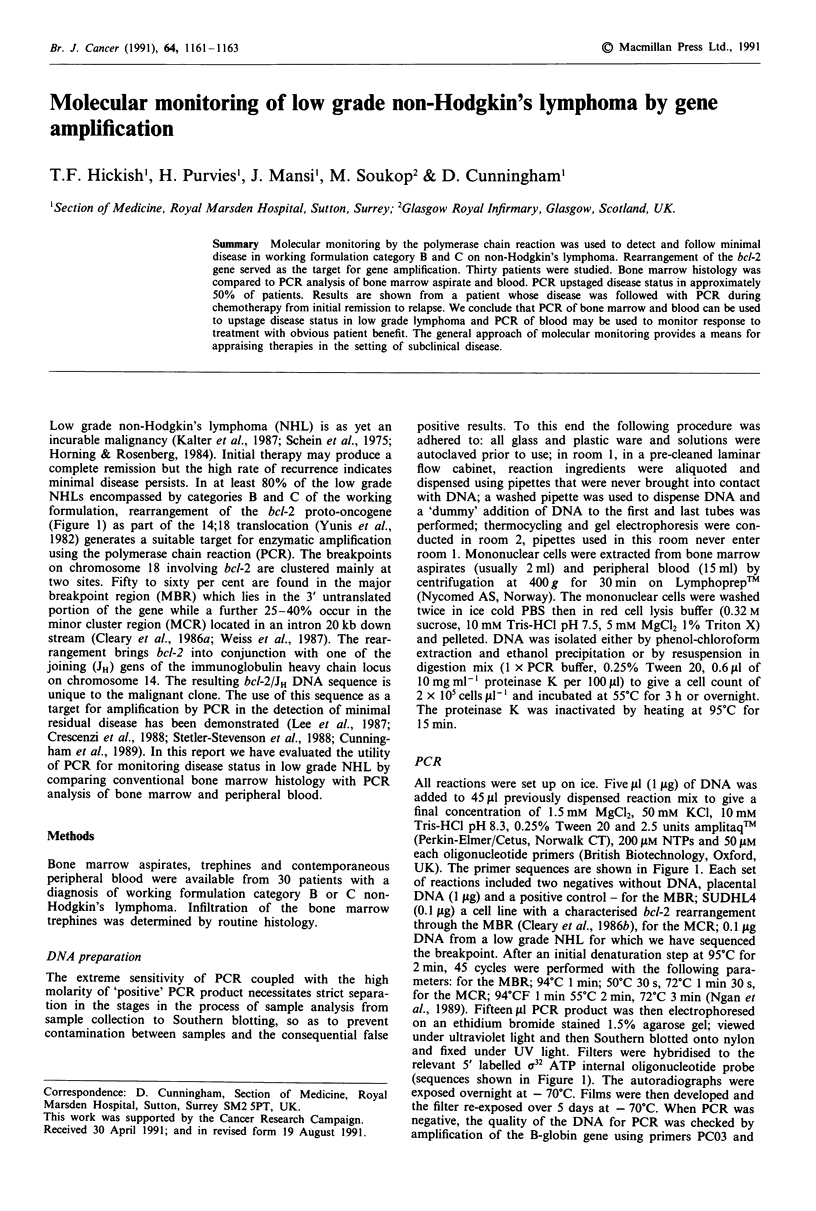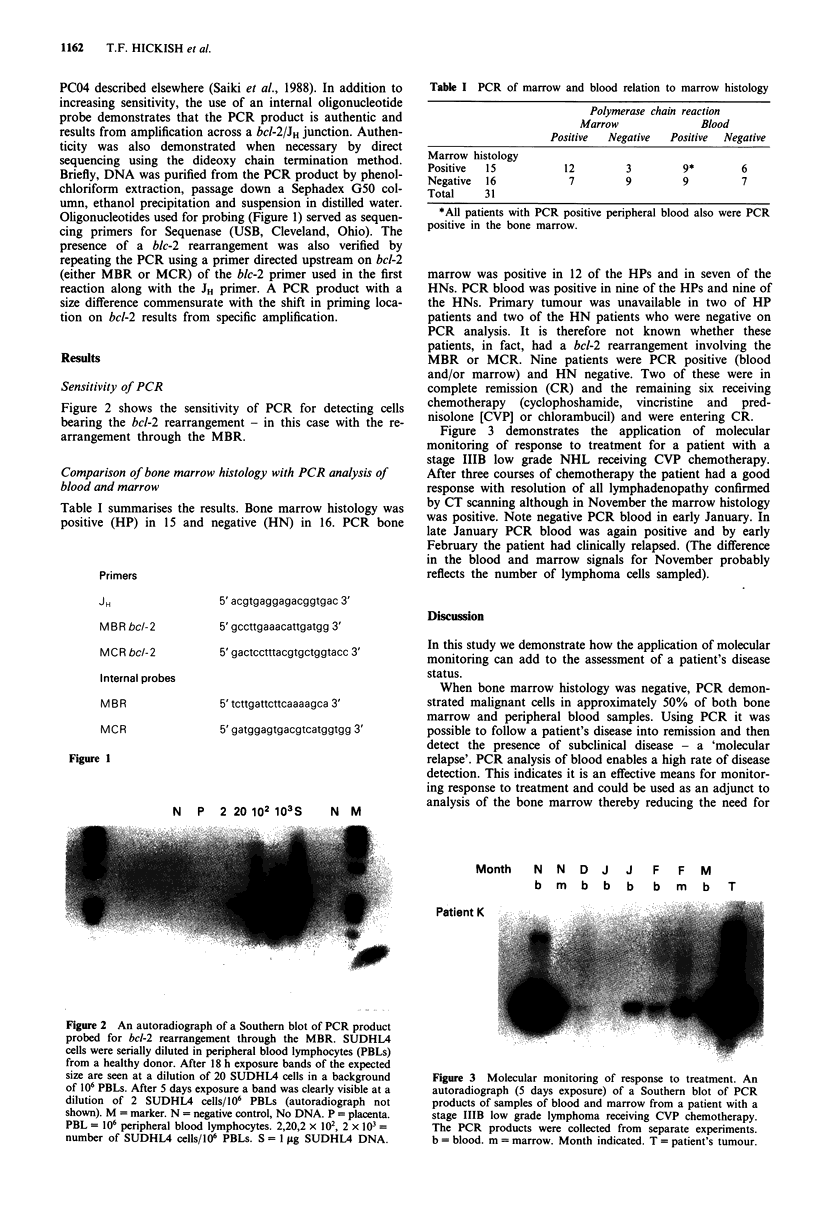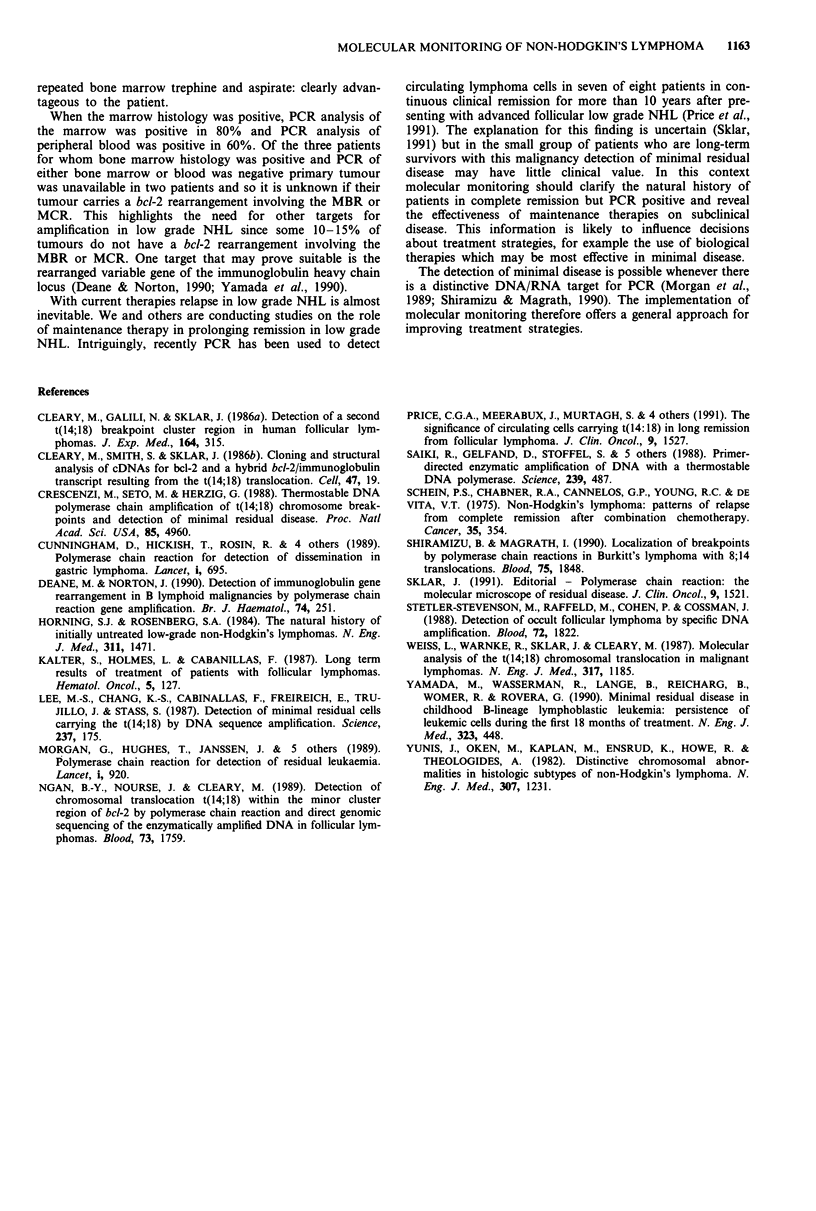Abstract
Molecular monitoring by the polymerase chain reaction was used to detect and follow minimal disease in working formulation category B and C on non-Hodgkin's lymphoma. Rearrangement of the bcl-2 gene served as the target for gene amplification. Thirty patients were studied. Bone marrow histology was compared to PCR analysis of bone marrow aspirate and blood. PCR upstaged disease status in approximately 50% of patients. Results are shown from a patient whose disease was followed with PCR during chemotherapy from initial remission to relapse. We conclude that PCR of bone marrow and blood can be used to upstage disease status in low grade lymphoma and PCR of blood may be used to monitor response to treatment with obvious patient benefit. The general approach of molecular monitoring provides a means for appraising therapies in the setting of subclinical disease.
Full text
PDF


Images in this article
Selected References
These references are in PubMed. This may not be the complete list of references from this article.
- Cleary M. L., Galili N., Sklar J. Detection of a second t(14;18) breakpoint cluster region in human follicular lymphomas. J Exp Med. 1986 Jul 1;164(1):315–320. doi: 10.1084/jem.164.1.315. [DOI] [PMC free article] [PubMed] [Google Scholar]
- Cleary M. L., Smith S. D., Sklar J. Cloning and structural analysis of cDNAs for bcl-2 and a hybrid bcl-2/immunoglobulin transcript resulting from the t(14;18) translocation. Cell. 1986 Oct 10;47(1):19–28. doi: 10.1016/0092-8674(86)90362-4. [DOI] [PubMed] [Google Scholar]
- Cunningham D., Hickish T., Rosin R. D., Sauven P., Baron J. H., Farrell P. J., Isaacson P. Polymerase chain reaction for detection of dissemination in gastric lymphoma. Lancet. 1989 Apr 1;1(8640):695–697. doi: 10.1016/s0140-6736(89)92208-3. [DOI] [PubMed] [Google Scholar]
- Deane M., Norton J. D. Detection of immunoglobulin gene rearrangement in B lymphoid malignancies by polymerase chain reaction gene amplification. Br J Haematol. 1990 Mar;74(3):251–256. doi: 10.1111/j.1365-2141.1990.tb02579.x. [DOI] [PubMed] [Google Scholar]
- Horning S. J., Rosenberg S. A. The natural history of initially untreated low-grade non-Hodgkin's lymphomas. N Engl J Med. 1984 Dec 6;311(23):1471–1475. doi: 10.1056/NEJM198412063112303. [DOI] [PubMed] [Google Scholar]
- Kalter S., Holmes L., Cabanillas F. Long-term results of treatment of patients with follicular lymphomas. Hematol Oncol. 1987 Apr-Jun;5(2):127–138. doi: 10.1002/hon.2900050207. [DOI] [PubMed] [Google Scholar]
- Lee M. S., Chang K. S., Cabanillas F., Freireich E. J., Trujillo J. M., Stass S. A. Detection of minimal residual cells carrying the t(14;18) by DNA sequence amplification. Science. 1987 Jul 10;237(4811):175–178. doi: 10.1126/science.3110950. [DOI] [PubMed] [Google Scholar]
- Ngan B. Y., Nourse J., Cleary M. L. Detection of chromosomal translocation t(14;18) within the minor cluster region of bcl-2 by polymerase chain reaction and direct genomic sequencing of the enzymatically amplified DNA in follicular lymphomas. Blood. 1989 May 15;73(7):1759–1762. [PubMed] [Google Scholar]
- Price C. G., Meerabux J., Murtagh S., Cotter F. E., Rohatiner A. Z., Young B. D., Lister T. A. The significance of circulating cells carrying t(14;18) in long remission from follicular lymphoma. J Clin Oncol. 1991 Sep;9(9):1527–1532. doi: 10.1200/JCO.1991.9.9.1527. [DOI] [PubMed] [Google Scholar]
- Saiki R. K., Gelfand D. H., Stoffel S., Scharf S. J., Higuchi R., Horn G. T., Mullis K. B., Erlich H. A. Primer-directed enzymatic amplification of DNA with a thermostable DNA polymerase. Science. 1988 Jan 29;239(4839):487–491. doi: 10.1126/science.2448875. [DOI] [PubMed] [Google Scholar]
- Schein P. S., Chabner B. A., Canellos G. P., Young R. C., DeVita V. T., Jr Non-Hodgkin's lymphoma: patterns of relapse from complete remission after combination chemotherapy. Cancer. 1975 Feb;35(2):354–357. doi: 10.1002/1097-0142(197502)35:2<354::aid-cncr2820350209>3.0.co;2-2. [DOI] [PubMed] [Google Scholar]
- Shiramizu B., Magrath I. Localization of breakpoints by polymerase chain reactions in Burkitt's lymphoma with 8;14 translocations. Blood. 1990 May 1;75(9):1848–1852. [PubMed] [Google Scholar]
- Sklar J. Polymerase chain reaction: the molecular microscope of residual disease. J Clin Oncol. 1991 Sep;9(9):1521–1524. doi: 10.1200/JCO.1991.9.9.1521. [DOI] [PubMed] [Google Scholar]
- Stetlet-Stevenson M., Raffeld M., Cohen P., Cossman J. Detection of occult follicular lymphoma by specific DNA amplification. Blood. 1988 Nov;72(5):1822–1825. [PubMed] [Google Scholar]
- Weiss L. M., Warnke R. A., Sklar J., Cleary M. L. Molecular analysis of the t(14;18) chromosomal translocation in malignant lymphomas. N Engl J Med. 1987 Nov 5;317(19):1185–1189. doi: 10.1056/NEJM198711053171904. [DOI] [PubMed] [Google Scholar]
- Yamada M., Wasserman R., Lange B., Reichard B. A., Womer R. B., Rovera G. Minimal residual disease in childhood B-lineage lymphoblastic leukemia. Persistence of leukemic cells during the first 18 months of treatment. N Engl J Med. 1990 Aug 16;323(7):448–455. doi: 10.1056/NEJM199008163230705. [DOI] [PubMed] [Google Scholar]
- Yunis J. J., Oken M. M., Kaplan M. E., Ensrud K. M., Howe R. R., Theologides A. Distinctive chromosomal abnormalities in histologic subtypes of non-Hodgkin's lymphoma. N Engl J Med. 1982 Nov 11;307(20):1231–1236. doi: 10.1056/NEJM198211113072002. [DOI] [PubMed] [Google Scholar]




